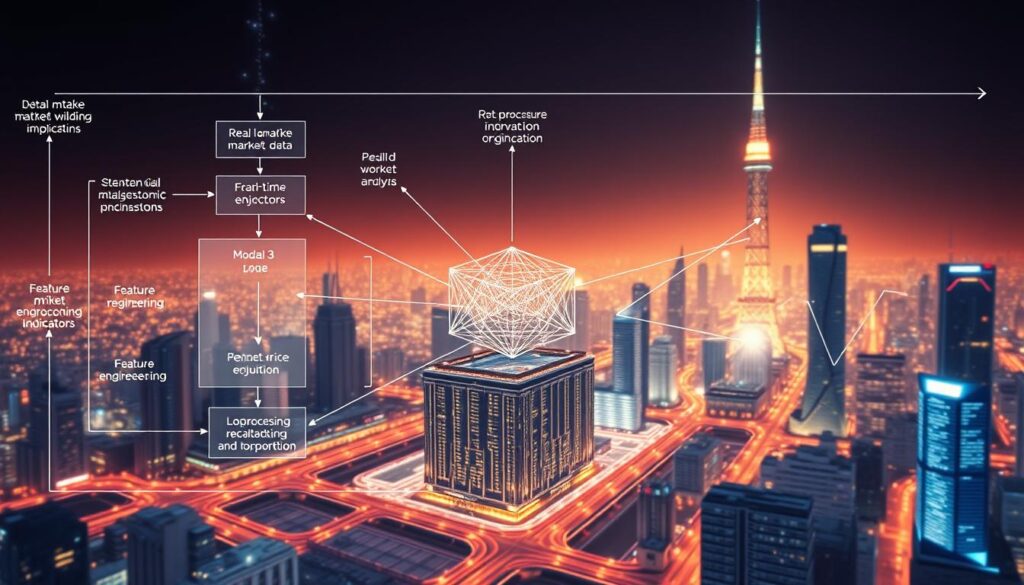Now Reading: Natural Language Processing Crypto News Analysis Insights
- 01
Natural Language Processing Crypto News Analysis Insights
Natural Language Processing Crypto News Analysis Insights

The digital asset landscape moves at lightning speed. Price swings are often driven by public perception and breaking information, not just traditional financial data. This makes understanding market mood more critical than ever.
Artificial intelligence is revolutionizing how we interpret this vast information flow. Advanced systems can now read and understand human language from thousands of sources. They turn complex text into clear, quantifiable data.
This technology helps traders and investors spot trends and make informed decisions. It provides a significant edge in a highly volatile environment. For a deeper look at how this works, explore our detailed sentiment insights.
This article will guide you through the core technologies behind this transformation. We will explain how machines extract meaning and measure the emotional tone of the market.
Key Takeaways
- Market sentiment is a powerful driver of digital asset prices.
- AI systems can process immense volumes of textual data in real-time.
- These tools convert qualitative information into actionable quantitative metrics.
- Staying ahead requires leveraging technology to interpret complex market narratives.
- Understanding these methodologies provides a competitive advantage for participants.
Introduction to AI and Crypto Market Trends
The convergence of artificial intelligence and cryptocurrency markets represents one of today’s most significant financial developments. Traditional analysis methods simply cannot keep pace with the rapid information flow that drives digital asset valuations.

Artificial intelligence systems now process millions of data points simultaneously. They’ve moved beyond basic chart reading to sophisticated sentiment measurement. This transformation gives traders unprecedented analytical capabilities in a space where perception often outweighs fundamentals.
Digital asset markets lack traditional valuation models found in stocks and bonds. This makes community mood and narrative momentum powerful price drivers. Recent data confirms this AI-crypto synergy is exploding.
According to Messari research, AI-related tokens saw a 120% market cap increase in Q1 2024. This growth stems from advanced AI agents within blockchain protocols. The trend highlights how crucial these technologies have become.
Information flows differently in cryptocurrency spaces compared to traditional finance. Social media platforms and decentralized communities play oversized roles in trend formation. Accurate sentiment measurement has become critical infrastructure for modern portfolio management.
Understanding these emotional undercurrents provides valuable trading insights. AI systems that interpret market sentiment effectively turn qualitative data into quantitative advantages. This capability separates successful participants from the crowd.
The Evolution of Cryptocurrency Analytics and NLP
Early attempts to understand market trends relied heavily on manual effort and basic data interpretation. Analysts would scan articles and forums, a slow process vulnerable to human bias.
This changed with the arrival of rule-based systems. They automated simple keyword matching but struggled with context and sarcasm common in digital asset discussions.

A major leap forward came with machine learning. These systems learned patterns from vast datasets of text. They began to grasp the subtle nuances of market language.
The development of large language models (LLMs) marked a new era. Open-source options like Llama, Falcon, and Mistral became available. This democratized access to powerful analytical tools.
These models can be fine-tuned for specific tasks in the cryptocurrency space. They excel at summarizing complex information and extracting key entities from news.
Retrieval-Augmented Generation (RAG) was another critical innovation. It allows models to pull in real-time data, ensuring analysis is current and accurate.
Breakthroughs like few-shot learning reduced development time. Models can now perform complex tasks with minimal examples. This has dramatically improved the speed and affordability of advanced analytics for traders and institutions.
Natural Language Processing Crypto News Analysis
Bohdan M. Pavlyshenko’s research represents a significant leap forward in how we extract meaning from cryptocurrency-related text. His system at Ivan Franko National University of Lviv uses a fine-tuned Mistral 7B model with retrieval-augmented generation.

This framework processes raw articles through multiple analytical layers. It generates both graphical and textual summaries with quantitative scores. The approach provides complementary perspectives on market information.
Structured JSON outputs make the results easily integrable into various applications. Trading algorithms and portfolio systems can consume this data directly. This creates immediate practical value for market participants.
The system’s hierarchical stacking methodology is particularly powerful. It consolidates individual summaries into comprehensive higher-level reports. This creates “summaries of summaries” that distill insights from vast data volumes.
This multilevel approach serves different analytical needs simultaneously. It offers granular detail for specific items while identifying broad patterns. For deeper understanding of market mood dynamics, explore our comprehensive sentiment analysis guide.
The workflow begins with article ingestion and progresses through entity extraction. Knowledge graphs structure the information before final synthesis. Each level adds another dimension of intelligence to the final output.
Graph-Based Representations in News Analytics
Graph-based systems offer a powerful alternative to traditional text analysis methods. They transform unstructured information into structured knowledge networks that capture complex relationships.

This approach represents a significant advancement in how we process market data. Unlike basic text matching, graph models understand how entities connect and interact.
Understanding Knowledge Graphs
Knowledge graphs organize information as nodes and edges. Nodes represent entities like companies or digital assets. Edges show relationships between them.
This structure enables sophisticated reasoning across interconnected data sources. Systems can validate claims by checking multiple relationship paths.
Combating LLM Hallucinations with Graph Models
Graph representations effectively address the hallucination problem in large language models. They ground outputs in verifiable relational structures rather than text patterns alone.
Microsoft Research’s GraphRAG system demonstrates this capability well. It combines entity extraction with community detection for robust fact-checking.
This hybrid approach ensures more reliable sentiment analysis and trend detection. The structural validation provides confidence in the resulting insights.
Stacking Approaches for Enhanced Trend Reporting
Multi-layered analytical frameworks deliver superior market intelligence by combining diverse perspectives. These systems treat individual model outputs as foundational building blocks for higher-level synthesis.
Stacking works through a two-stage process where base-level responses feed into a meta-learner. This second-stage component learns optimal weighting strategies to reduce individual model bias.
Consensus Reasoning and Hierarchical Summaries
Frameworks like Iterative Consensus Ensemble (ICE) refine predictions through repeated passes. They build agreement across different model outputs, significantly increasing reliability.
Hierarchical summarization pipelines create progressively higher-level insights. First, detailed summaries extract from individual articles. Then, systems synthesize these into meta-summaries capturing broad patterns.
Quantitative opinion scoring aggregates sentiment measurements across multiple sources. This approach provides trend scores with uncertainty estimates for better decision-making.
Probabilistic stacking enables risk assessment for predictions. Decision-makers receive not just point estimates but confidence intervals. This comprehensive approach captures both consensus viewpoints and emerging divergences in market trends.
PEFT and LoRA: Cost-Efficient LLM Fine-Tuning
The development of cost-effective fine-tuning methods has revolutionized how researchers approach large language models. Parameter-Efficient Fine-Tuning (PEFT) and Low-Rank Adaptation (LoRA) represent breakthrough techniques that democratize access to custom model development.
Traditional full fine-tuning requires enormous computational resources and specialized hardware. This approach often costs thousands of dollars, placing it beyond reach for most researchers and small organizations.
PEFT/LoRA works by freezing pre-trained model weights while injecting small trainable matrices into transformer layers. This reduces trainable parameters by 99% or more while maintaining comparable performance.
Practical implementations combine these methods with 4-bit quantization techniques. This further reduces memory requirements, enabling fine-tuning of 7 billion parameter models on accessible platforms like Google Colab.
Successful configurations use specific training arguments for optimal balance. These include batch sizes of 2, gradient accumulation steps of 4, and learning rates of 3e-5 over 7 epochs.
These cost-efficient approaches enable rapid experimentation and iteration. Developers can create multiple specialized models for different analytical tasks without prohibitive expenses.
The democratization of advanced tools accelerates innovation across various applications. Academic researchers and independent developers can now compete with well-funded institutions in developing state-of-the-art analytical solutions.
Sentiment Analysis in Cryptocurrency News
Beyond simple positive or negative labels, today’s systems generate nuanced scores that capture intensity and momentum. These quantitative techniques transform subjective opinions into structured data that trading algorithms can use.
Quantitative Sentiment Scoring Techniques
Neural network classifiers scan real-time information from Twitter, Reddit, and major publications. They process millions of messages to gauge the emotional pulse of the market.
Modern classification is highly sophisticated. It measures sentiment strength, confidence levels, and identifies the specific digital asset being discussed. This precision is vital for accurate interpretation.
These systems are uniquely adapted to the digital asset world. They understand community slang like “HODL” and “FUD,” as well as the sarcasm common in online forums. This adaptability is a key advantage over older methods.
The output is a set of actionable metrics. These scores provide a clear, numerical view of market emotion.
| Metric | Description | Typical Range | Application |
|---|---|---|---|
| Polarity Score | Overall positive or negative tone | -1.0 to +1.0 | General market outlook |
| Strength Indicator | Intensity of the expressed emotion | 0 to 10 | Measuring conviction levels |
| Sentiment Momentum | Rate of change in sentiment over time | Percentage change | Early trend detection |
| Source Divergence | Difference in sentiment between platforms | Divergence score | Identifying conflicting signals |
Research confirms that adding these features to forecasting models improves price prediction accuracy. Tracking sentiment evolution helps detect trend reversals early.
Validation remains critical. Systems are backtested against actual price movements to ensure their predictive value. They also account for potential manipulation and bot activity.
Retrieval-Augmented Generation (RAG) in Modern Analytics
Retrieval-Augmented Generation represents a fundamental shift in how analytical systems access and utilize information. This architecture combines language understanding with real-time data retrieval for superior results.
The RAG workflow operates through a two-step process. First, it searches external knowledge bases for relevant facts. Then, it feeds this context to the language model for informed responses.
This approach addresses critical limitations of standalone models. It effectively mitigates hallucination problems where systems generate plausible but incorrect information. The technique also solves the staleness issue in fast-moving markets.
Traditional implementations segment documents into fixed chunks. They use vector similarity search to find relevant passages. While effective for simple queries, these systems struggle with complex reasoning across multiple sources.
Advanced architectures like GraphRAG use hierarchical community detection. They create structured summaries of semantically related entities. HippoRAG models associative memory processes through knowledge graphs.
| Architecture | Retrieval Method | Key Advantage | Best For |
|---|---|---|---|
| Traditional RAG | Vector similarity search | Simple implementation | Direct fact retrieval |
| GraphRAG | Community detection | Complex relationship mapping | Multi-source analysis |
| HippoRAG | Associative memory | Contextual understanding | Temporal pattern recognition |
In practical applications, RAG enables systems to answer complex questions about market movements. It retrieves relevant articles, extracts sentiment measurements, and synthesizes comprehensive answers. This provides significant advantages for decision-makers.
Comparative evaluations show RAG-enhanced systems achieve higher accuracy and better factual grounding. They deliver more useful outputs compared to non-augmented models across various analytical tasks.
Integrating Data-Driven Insights with NLP Tools
The integration of diverse data streams with computational linguistics tools represents a paradigm shift in digital asset evaluation. Modern platforms combine real-time price feeds, trading volumes, and blockchain metrics with advanced text analysis capabilities.
These systems employ graph theory to map relationships between entities in the cryptocurrency ecosystem. They identify influential voices and user communities through sophisticated network analysis. This approach reveals semantic structures that drive market movements.
Quantitative characteristics from semantic frequent itemsets serve as powerful features in predictive models. Recurring patterns in news and social media content become measurable indicators of market sentiment. These insights feed into regression models for price prediction.
Practical implementation requires robust data pipeline design and API integration strategies. Systems must synchronize sources with different update frequencies while maintaining data integrity. Case studies demonstrate that integrated approaches provide superior insights compared to siloed methods.
Visualization tools present these complex data relationships in actionable formats. Dashboards help traders quickly understand multi-dimensional information landscapes. This comprehensive approach transforms raw data into strategic market intelligence.
Automated Trading and Market Sentiment Strategies
The evolution of algorithmic systems has created powerful tools that translate sentiment patterns into profitable trades. These platforms process millions of data points from social media and news sources in real-time.
Different approaches leverage sentiment insights for market advantage. Momentum strategies buy during positive sentiment surges. Contrarian methods fade extreme emotional readings. Mean-reversion techniques exploit sentiment-driven overreactions.
Automated systems offer significant performance benefits. They achieve superhuman processing speeds while filtering irrelevant information. This scalability enables simultaneous monitoring of hundreds of assets.
Reinforcement learning allows these tools to continuously improve. They learn from successful and unsuccessful trades to refine position sizing rules. This adaptability creates increasingly sophisticated market models.
| Strategy Type | Sentiment Trigger | Risk Level | Best For |
|---|---|---|---|
| Momentum | Positive surge detection | Medium-High | Trend followers |
| Contrarian | Extreme sentiment readings | High | Experienced traders |
| Mean-Reversion | Overreaction identification | Medium | Risk-averse users |
Risk management remains critical in automated trading. Sentiment analysis helps avoid emotional market pumps and identify manipulation patterns. Proper stop-losses based on sentiment momentum protect against sudden reversals.
Implementation varies by trader type. Retail investors use sentiment-enhanced portfolio tools. Institutional firms deploy proprietary high-frequency algorithms. Both benefit from real-time emotional data interpretation.
Mistral 7B LLM: A Game Changer in Crypto News Analysis
Among open-weight language models, Mistral 7B has emerged as particularly effective for processing complex market information. This 7-billion parameter model delivers performance comparable to larger alternatives while maintaining efficiency.
The architecture incorporates innovative features like Sliding Window Attention. This allows efficient handling of lengthy articles and discussion threads. Grouped-Query Attention accelerates inference for real-time applications.
For cryptocurrency applications, the model strikes an optimal balance. It understands sophisticated financial concepts while remaining cost-effective to deploy. Organizations can fine-tune it on specialized datasets without massive infrastructure.
The fine-tuning process focuses on multi-level analytical tasks. These include knowledge graph construction and quantitative sentiment scoring. The system generates structured JSON outputs for easy integration.
Benchmarks show competitive performance against larger models in specific tasks. The open-weight approach enables private deployment and customization. This addresses privacy concerns while allowing proprietary enhancements.
Practical implementation involves leveraging pre-trained versions. Organizations can adapt them to cryptocurrency-specific datasets. The broader ecosystem includes advanced variants like Mixtral-8x7B for future applications.
Decentralized Finance and the Role of AI Innovations
A new generation of decentralized platforms is emerging where AI services become native components of the protocol architecture. This integration creates powerful tools for analyzing digital asset markets and automating complex financial operations.
Leading projects demonstrate how blockchain technology enables distributed intelligence. These systems transform how we interact with financial platforms and process market information.
Blockchain Integration with NLP Solutions
SingularityNET (AGIX) operates as a decentralized marketplace for AI services. It hosts specialized agents that understand human language and process financial data. Users can combine these capabilities for sophisticated trading insights.
Ocean Protocol (OCEAN) addresses privacy concerns in crypto data analysis. Its federated learning approach allows nlp models to train on decentralized datasets without exposing sensitive information. This preserves user privacy while enabling robust model development.
Fetch.ai (FET) deploys autonomous economic agents that communicate using advanced language processing. These agents facilitate complex negotiations across decentralized commerce environments. They analyze market sentiment and execute trades based on sophisticated reasoning.
Technical integration presents challenges for resource-intensive AI models on blockchain platforms. Solutions include off-chain computation with on-chain verification and cryptographic proof systems. These approaches maintain decentralization while supporting advanced analytics.
Emerging use cases include conversational interfaces for decentralized exchanges and AI-powered advisors. These tools help traders navigate volatile cryptocurrency markets by interpreting complex sentiment patterns. The economic implications involve token-based incentives for continuous model improvement.
Real-World Use Cases in Crypto and AI
The gap between theoretical AI capabilities and practical cryptocurrency applications has been bridged by several pioneering platforms. These systems deliver tangible value by processing vast amounts of market data.
LunarCrush exemplifies this approach, scanning millions of social posts daily. It generates proprietary metrics like “AltRank” and “Galaxy Scores” that quantify social engagement and sentiment polarity.
Kleros developed the KAI assistant to guide users through complex arbitration processes. This reduces technical barriers for participants in decentralized governance systems.
A compelling example emerged in early 2025 when Bitcoin gained over 8%. Neural classifiers detected a sentiment surge around ETF approval speculation before the price movement.
| Platform | Primary Function | Key Metric | Target User |
|---|---|---|---|
| LunarCrush | Social sentiment tracking | Galaxy Score | Traders & Analysts |
| Kleros KAI | Governance assistance | Case completion rate | Protocol participants |
| ChainGPT | Smart contract generation | Code accuracy | Developers |
Emerging applications include smart contract generation from natural language prompts. Projects like ChainGPT and AIWork are democratizing blockchain development.
These platforms provide critical insights for crypto AI trading algorithms. They transform complex data into actionable trading signals.
Social Media Influence on Cryptocurrency Market Dynamics
The velocity of information flow on social networks now directly impacts cryptocurrency price movements in measurable ways. Platforms like Twitter and Reddit serve as primary channels where community discussions often drive market action.
Graph analysis algorithms map how information spreads through these networks. They model users as nodes and interactions as edges, creating mathematical structures that reveal propagation patterns.
Graph Analysis and Sentiment Propagation
These systems distinguish between organic community enthusiasm and artificial manipulation. They identify influential voices whose posts disproportionately affect market sentiment.
Influence detection methodologies differentiate between accounts with genuine reach versus inflated follower counts. This helps traders focus on signals that truly matter.
Sentiment propagation modeling tracks how emotional tones spread through networks over time. It reveals whether bullish or bearish trends are accelerating or reversing.
Bot detection techniques flag coordinated inauthentic behavior using graph patterns. This provides crucial protection against artificial hype campaigns.
Temporal dynamics show how sentiment velocity often predicts price movements with hours or days of lead time. This creates actionable trading signals for market participants.
Future Innovations in NLP-Powered Crypto Market Strategies
Autonomous economic agents capable of negotiating complex trades mark a significant evolution in market participation. These intelligent systems will act independently, discovering opportunities across multiple platforms.
Wallet technology is undergoing a fundamental shift toward conversational interfaces. Users will receive personalized guidance based on their portfolio context and risk tolerance. This represents a major advancement in user experience.
Decentralized organizations will leverage computational linguistics for governance. Systems will automatically parse proposals and detect manipulation attempts. They’ll generate plain-language summaries for global community participation.
Regulation-aware monitoring will provide real-time compliance alerts. These tools scan legal documents across jurisdictions, suggesting adaptation strategies. This addresses growing regulatory complexity in digital assets.
Multimodal analysis combines text, audio, and video sources for comprehensive sentiment assessment. Real-time translation breaks language barriers in global markets. These features enable deeper insights into emerging trends.
The potential for truly personalized experiences represents the next frontier. Systems will adapt communication style based on individual knowledge levels. This creates more accessible and effective market intelligence tools.
Conclusion
As computational systems continue to evolve, their ability to interpret human communication is reshaping trading strategies across global exchanges. The journey from manual data review to automated insight generation represents a monumental shift in market participation.
Breakthrough technologies like retrieval-augmented generation and graph-based representations have transformed qualitative information into actionable quantitative metrics. Cost-efficient fine-tuning methods have democratized access to sophisticated analytical tools previously available only to large institutions.
Sentiment measurement has evolved from experimental concept to essential infrastructure, driving significant trading volume daily. These systems provide speed, accuracy, and scalability advantages that create meaningful competitive edges.
Looking forward, computational linguistics will transition from competitive advantage to fundamental requirement. Market participants who leverage these capabilities will navigate volatile conditions more effectively than those relying on traditional methods alone.
FAQ
How does machine learning improve the analysis of cryptocurrency news?
Machine learning models can automatically process vast amounts of text data from news articles and social media. They identify key trends, entities, and sentiment shifts, providing traders with faster, data-driven insights than manual methods.
What is sentiment analysis in the context of digital assets?
Sentiment analysis uses artificial intelligence to gauge the emotional tone of text, such as news headlines or social media posts. For cryptocurrencies, it helps quantify market mood, which can be a powerful factor influencing price and trading volume.
Can AI tools predict cryptocurrency price changes?
While no tool can predict prices with certainty, AI and NLP systems analyze information like news flow and social media chatter to identify potential market-moving events. These insights help inform trading strategies by highlighting risk and opportunity.
What are the benefits of using graph-based models for news analytics?
Graph models create connections between entities like coins, exchanges, and events. This helps combat misinformation from AI models by providing a structured knowledge base, leading to more accurate and reliable trend reporting.
How do cost-efficient fine-tuning methods like LoRA benefit analysis?
Techniques like Low-Rank Adaptation (LoRA) allow for the efficient customization of large language models for specific tasks, such as analyzing DeFi protocols. This reduces computational costs while maintaining high performance for specialized analytics.
What role does social media play in market dynamics?
Platforms like Twitter and Reddit can significantly influence cryptocurrency values. NLP tools analyze this data to track sentiment propagation and identify emerging trends that may impact trading strategies and asset prices.















